There were two items that I really looked forward to receiving and using last year. One was the 2011/12 Black Diamond Carbon Justice skis, and the other some “magic elf boots”, AKA the Dynafit TLT5 Performance AT boot. The Justices will be arriving on shop shelves in the next month or two (and is bound to be a hit with Joe Public BC powder skier) but the TLTs have been out for a full season so far and have already gained quite the following…and for good reason.
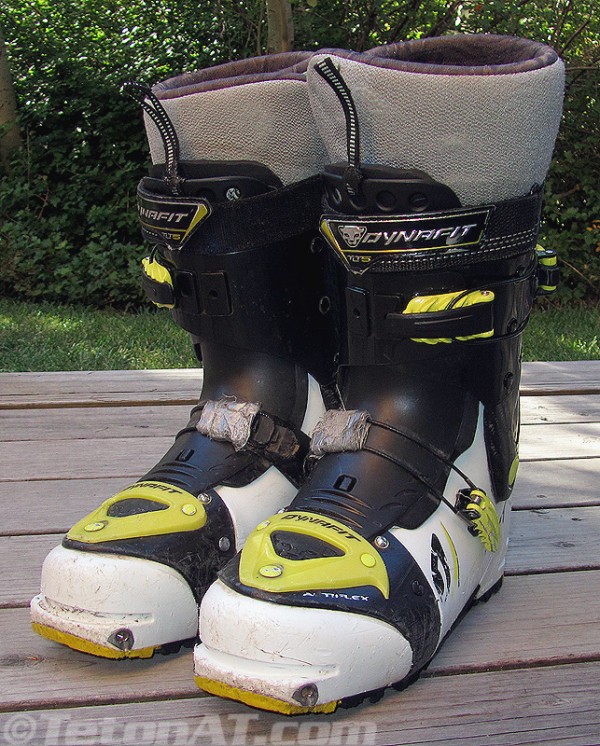
My TLT5s…75+ days and counting.
I’ve run with a gamut of different models of AT boots over the past 10-15 years (Dynafit All-Terrain/Z-Zero/Titan/TLT Race, Scarpa Denali/Matrix/Spirit3/Spirit4/F1, Black Diamond Factor/Quadrant/Prime) and have always been on the search for the perfect boot that combines lightweight and ease of touring, with relative stiffness and performance for the downhill. I don’t need the stiffest or lightest boot on the market, but I do want a combination of the two that can stand up to aggressive skiing in mostly soft snow conditions, as well as not weigh me down so I can stay light on my feet for sprints on the Glory bootpack and have the endurance to tick off long tours in extreme comfort in the Tetons or anywhere else I am skiing.
As far as boot design and manufacturing goes, it’s easy to make a boot stiff, and it’s easy to make a boot light, but bringing those two characteristics together in a durable and affordable package is a trick few AT boots can really claim to have done. The TLT5 has come the closest to pairing most of the qualities I like so far in an AT boot and has held up okay over the span of 7 months (January-July 2011) and an estimated 75 days of backcountry skiing. There were a few parts that failed on me and a few things I would like to change with the boot (see below), but generally I was quite happy with the performance of the Dynafit TLT5 Performance boot and honestly, had a hard time going back to touring in some of the other boots in the my quiver.
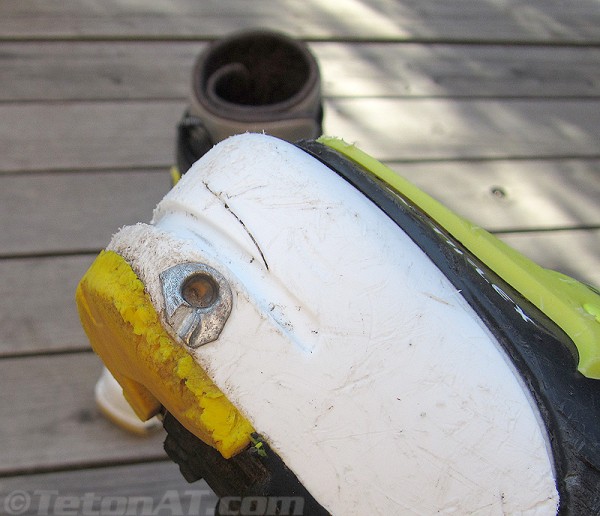
Decent outsole durability at the pins of the boot.
For a quick run down, the TLT5 is a 3-piece tongue style boot that comes in two versions. The Performance model has a carbon fiber upper cuff, where as the Mountain version is made with a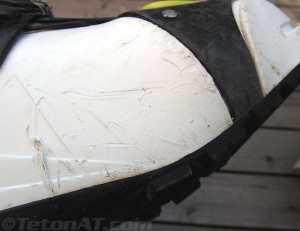 cheaper and less stiff Pebax cuff. The design of the boots is the same and the lower section is made with Grilamid, a lighter form of plastic compared to Pebax or PU. The walls of the boot are kept thin and the overall profile of the TLT5 is quite low, which keeps the weight down to a minimum. Durability of the Grilamid and the thin-ish walls of the lower shell has proven to be acceptable, and even after miles of walking on rocks, which has produced some pretty deep gouges in the shell, there are no cracks or punctures.
cheaper and less stiff Pebax cuff. The design of the boots is the same and the lower section is made with Grilamid, a lighter form of plastic compared to Pebax or PU. The walls of the boot are kept thin and the overall profile of the TLT5 is quite low, which keeps the weight down to a minimum. Durability of the Grilamid and the thin-ish walls of the lower shell has proven to be acceptable, and even after miles of walking on rocks, which has produced some pretty deep gouges in the shell, there are no cracks or punctures.
There are only two buckles and a power strap in TLT5’s design, but they did a good job of holding my foot in place for blister free ups and slop-resistance descents. The top buckle opens to the side and also works as the ski/walk mechanism. I found the top buckle to be a little cumbersome and vulnerable to damage from rocks/logs when in the open/walk position, but it has held up and nothing has gone wrong with it so far. The cables associated with the top buckle have gotten all twisty on my pair of TLT5s, but is still fully functional and not a big deal. I found simple, stretchy, non-double cuffed pant gaiters to work best with the side-throw top buckle, as double gaiters and beefier materials were harder to manipulate over it when in the open/walk position.
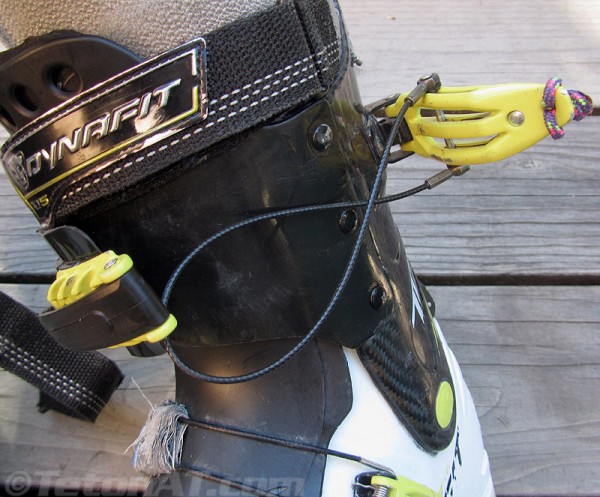
One of my upper cable got all twisty, but it’s no biggie.
The lower buckle on the TLT5 is very small, slightly spring loaded and clamps over the top of the skier’s instep. I found it’s location to be adequate and I often would loosen it for the up and tighten it for the way down. Under certain skinning/booting conditions (crusty snow) when I had the buckle loosely clamped, I had a hard time keeping the buckle down and it would often pop up and open. Surprisingly, since it is so small, it didn’t ever break. However, the little spring on one of them did, though it is still fully functional.
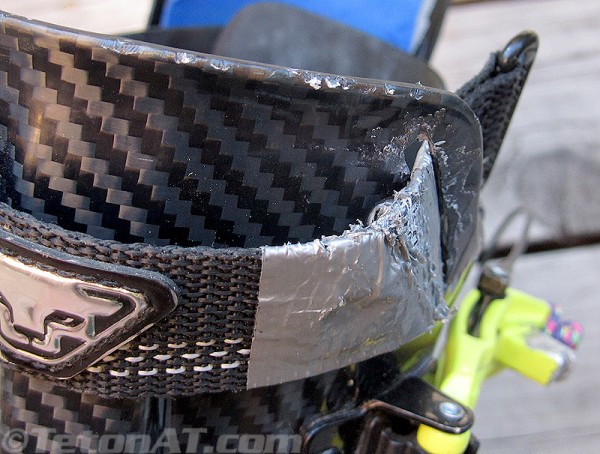
After the grommets tore through the powerstrap, I ground
some slots in the cuff to weave the powerstrap though.
Like many AT boots on the market, the powerstrap is often a place where manufacturers come up short. The TLT5 has a simple, Velcro strap that is held on to the upper cuff by two grommets. After not much use, these grommets pulled through the strap material and left the powerstrap barely functional. At first, I repaired the connection with larger grommets, but they slowly worked their way through the strap as well and I was forced to baby it for quite some time. Finally, I got the nerve to make a more permanent fix by dremelling out two slots in the upper section of the carbon fiber cuff and weaving the powerstrap through them. So far, so good with the fix and I think it will hold up for the long haul…and it’s even lighter than the original design.
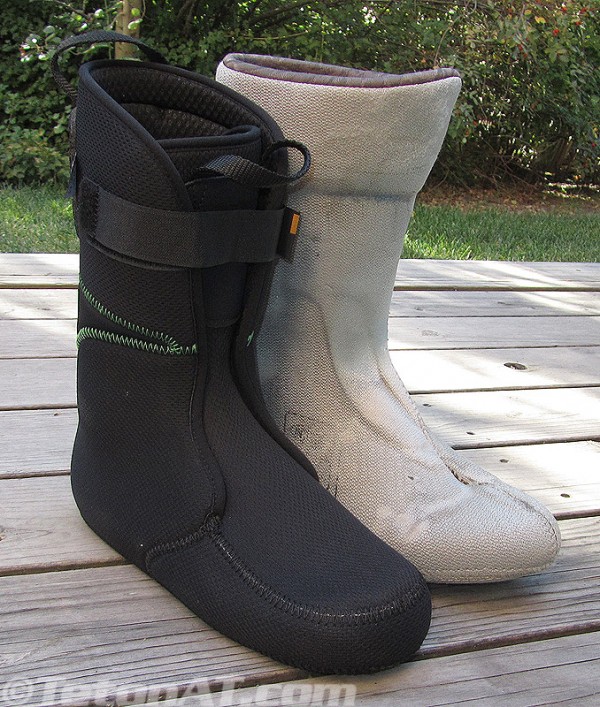
I didn’t bother with the stock liners, but they have
some nice “flex-zones” and are quite light.
I’m an Intuition liner snob and I didn’t use the stock liners that come with the boot at all, mainly because they are kinda flimsy for my taste. Intuition liners are taller, stiffer and add more padding than than the stock liners, which helps to add a bit more support and performance to most boots…which I like. My favorite Intuition liner for AT is the old school Alpine Wrap model. Some people like tongue style liners because they work better when touring, but I like the wrap styles because they offer a more uniform closer and more support at the top and on the sides of the upper cuff. Some models of Intuition wrap liners are made with stiffer foam, which is nice for the down, but can limit a liner’s touring capabilities. However, the Alpine Wrap doesn’t have any of the stiffer foam in it, so it remains quite flexible and nice for touring, yet still offers the wrap closure I like.
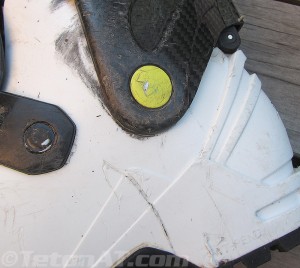 One place that I am mostly concerned with wear is at the inner cuff/lower shell rivet/interface.  I find most AT boots tend to develop slop, or movement, in this location after about 100 days of use. I think carbon fiber might wear a bit faster than Pebax or PU though and I have developed about 1-2mm of play at the rivet so far.  I think AT boot manufacturers often over look this highly abused and exposed area of AT boots (since they all use more or less use the same design) and an improvement in design with bushings, or something, would be nice.
One place that I am mostly concerned with wear is at the inner cuff/lower shell rivet/interface.  I find most AT boots tend to develop slop, or movement, in this location after about 100 days of use. I think carbon fiber might wear a bit faster than Pebax or PU though and I have developed about 1-2mm of play at the rivet so far.  I think AT boot manufacturers often over look this highly abused and exposed area of AT boots (since they all use more or less use the same design) and an improvement in design with bushings, or something, would be nice.
Ski touring in the TLT5s is so dreamy that it really does feel like you are wearing tennis shoes and cheating when you are touring with those that don’t have them. The articulation in the cuff is smooth and has a large range of motion (~ 60 degrees), both forward and backward, which really helps when banging out the miles on the flats, which we often have to do here in the Tetons. The tongue of the TLT5s is removable, which I would take advantage of for the ups and then put it back in the downhill. Some remove the tongue all together, but I like the downhill performance it adds and I don’t need to have the absolute lightest boots or fastest transitions when out playing in the snow (racing is a different story), so I don’t need to obsessed with those factors.
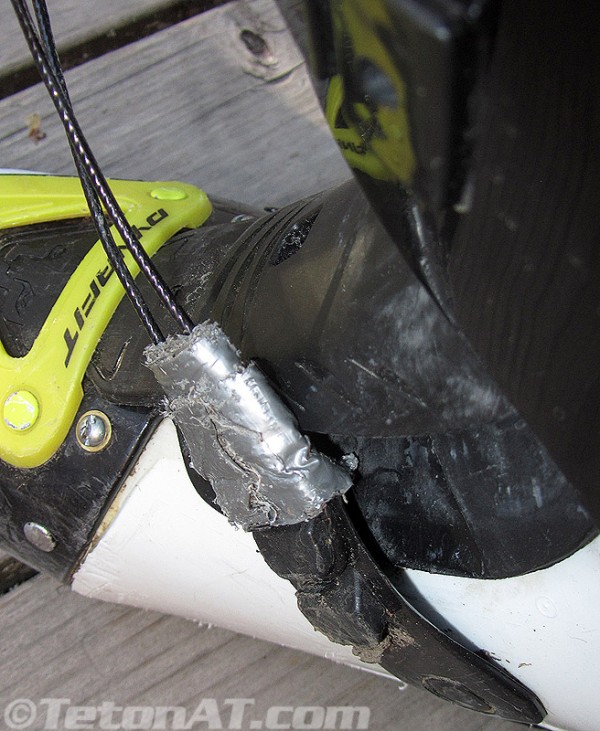
Some duct-tape on the lower cables kept the tongue from
binding up when inserting it into the boot.
I did find that the tongue would occasionally catch the interface between the cable and the plastic section of the lower buckle when putting them back in. A little duct-tape to smooth out that area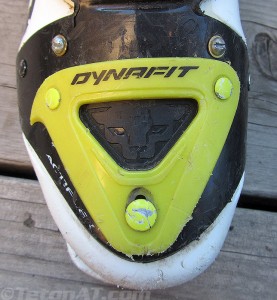 has seemed to help avoid this and adds to the hardcore backcountry skier look I strive for. I usually completely unclip the lower cable from the buckle when reinserting the tongue (the top cable can remain connected to the buckle), as I found it took too much force and tweaking to slam it in with the cable connected to the buckle.
has seemed to help avoid this and adds to the hardcore backcountry skier look I strive for. I usually completely unclip the lower cable from the buckle when reinserting the tongue (the top cable can remain connected to the buckle), as I found it took too much force and tweaking to slam it in with the cable connected to the buckle.
To add to the walking/touring characteristics of the TLT5, Dynafit has built a pseudo bellows section called Acti-Flex, which allows for a very slight flex in the toe of the boot. I found that you could just barely feel the boot flex on both the uphill and the downhill, but it didn’t bother me too much, even though I used to hate flexible bellows when rando racing in boots like the Scarpa F1. One down side of the Acti-Flex section s that it is secured to the boots with 5 rivets and two of them popped on me on each boot. I fixed them with some simple T-nuts and now the connection is bomber.
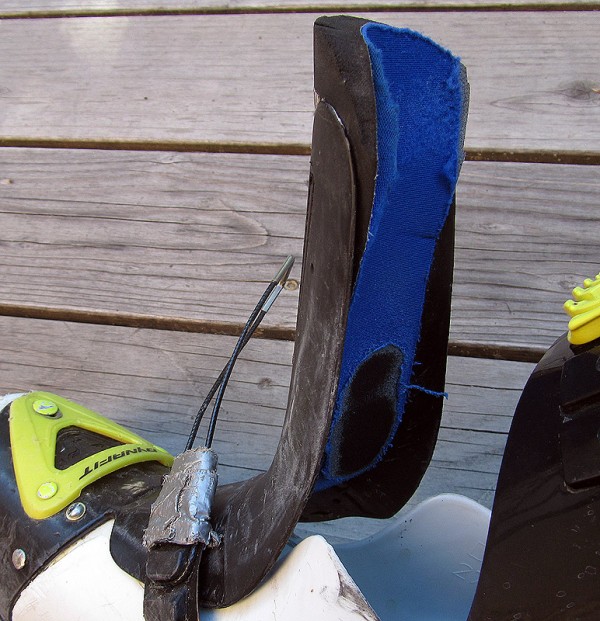
For me, a wedge shaped piece of foam dialed in the forward lean.
The TLT5 only has one forward lean setting for ski mode, which is quite far forward and forces you to really bend at the ankles.  At first I wasn’t sure I liked how far forward it was putting me, but over time I adapted and grew accustomed to it.  After a bit though, I added a small wedge shaped piece of foam on the inner tongue, which puts me a bit more upright now and I am currently very happy with the skiing position. Rumor has it the ski/walk mode in future TLT5s will have two forward lean settings, so that will be nice if it is indeed true.
Not only have the Dynafit TLT5s become quite popular with skiers, but they have also drawn the attention of alpinists looking for one boot to do it all on the approach, as well as climbing. Â Many alpine climbs require a ski approach, so having tech-fittings in your climbing boots is a real bonus. Â Add in the lightweight and low profile of the TLT5s and you have a prefect ice climbing/mixed terrain boot.
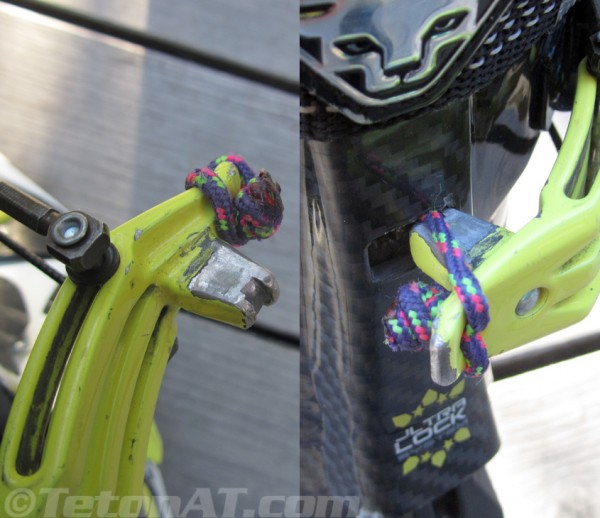
This little modification allows you to clamp down the upper buckle
and keep the cuff from locking into ski mode.
One critique I read about the TLT5 though was that when in walk mode, there might be too little calf support when front pointing on hard ice and it would be nice to be able to tighten the upper cuff but not have it lock into ski mode.  I read how someone fixed this by filing a notch in the upper buckle and adding some cord that they could flip into the notch, which would in-turn prevent the upper cuff from locking into ski mode when the upper buckle was clamped down.  I did this modification to my boots, but I haven’t had the opportunity to really put it to the test yet, as I haven’t found the support to be lacking enough to mess with the buckles.
If you can’t tell, I really like the TLT5s. You sacrifice a bit on the downhill with a boot like this, but it is so light, tours fantastically and is stiff enough for most folks for general ski-touring and powder slaying. Charging hard on the downhill in variable snow conditions, hitting airs and driving super-fat and heavy skis is a bit more challenging with the TLT5s, bit it is doable and will make you a better skier in the long run. The fattest skis I used them with were 175cm BD Carbon Justices (138-111-123), which I had no problems pairing them with. I think it would be a bit harder to drive the 185cm length in the same ski (which is also wider than the 175) or anything much fatter or heavier.
Anyway, that’s the take-away from having skied most of the 2010/11 season in the TLT5’s and I’m hoping they can hold up for another 100+ days of ski touring.

Do you remember what size rivets you used to repair the bellows on your boots?
bob…don’t remember the size t-nut i used, but it was your garden variety three spiked one…like this.
i was a little concerned about the aggressive spikes and how much volume the t-nut would take up on the inside and the boot, so i used a grinder and ground the spikes way down, as well as the sides of the t-nut to make it much lower volume.
Thanks for the review. How about a head to head comparison in terms of skiing power compared to some of your other boots (zzeros, quadrants, titans etc)?
I think the Z-Zero, Quadrant, Prime, Titan, Factor, Method are all more powerful boots than the TLT5 Performance. I guess I would say the TLT5p skis similarly to a Spirit 3…hard to judge really. The main competitor to this boot is the Scarpa Maesrtale though…which I didn’t think had as nice of a progressive flex as the TLT5p and felt like a brick wall slamming too low into my shins when I demo’d it.
Dood,
What size are your original liners? Any chance they are 27? If so, I’ll buy them from you.
Jared
I have the TLT5 mountains, and the biggest ski they seem to drive ok for me is the Dynafit stoke 182cm at 130/106/120mm, like you said just gotta stay centerered and ski techniclly well……
j-rad…they are 27s. but for now, i will probably hold on to the stock liners for if/when i decide to sell/pass-on the shells. sorry!
yeah kirk…probably similar surface areas between the 175 justice and 182 stoke. last season i saw one local dude using the tlt5p with some megawatts…so it shows that anything is “doable”.
No problem. What kind of Intuition liners did you put in?
like it says…the alpine wrap model.
http://www.intuitionliners.com/alpine_page.htm
knowing the kind of gear you use and skiing you do, my suspicion is that you would probably want the pro tour.
http://www.intuitionliners.com/lux_touring_page.htm
I’ve got protour liners on back order…..the stock ones even on the mtns packed out in about 20days.
Great review Steve – I have been trying to run a single quiver system the past couple of years with the Titan, but the reviews of these continue to want to push me back into a dedicated touring boot. Maybe one more year on the Titans for everything, and it will be time to make the jump!
thanks nick! the titan is a good choice, as well as the bd quadrant, for a single boot quiver for resort and BC skiing…especially with a beefier aftermarket liner. but once you taste the tour-ability of the TLT5…it’s hard to want to ski tour in anything with less range of motion in the cuff.
those look sweeeet….may be time to upgrade from my ’05 dynafit aero freerides!
Wow you sure put a hurtin on your boots. Is that 75 days total or just backcountry?
yeah bnk…~75 days of backcounty skiing on them. i got them in early january and skied through mid july last year.
hey steve,
have you tried out the titan ultralights? i skied them a bunch last year, with a beefier liner than the stock (which for whatever reason made the fit feel weird for me), and loved them, in resort and out. they seem like a sort of “magic elf shoe” for those of us in the 200 lbs-club. definitely keeping them for the season ahead and planning on paring them with a new intuition liner.
cheers, tim
yeah tim…i didn’t use the liners that came with the titans either. my guess is that the ultralight will ski similarly, but be lighter. less lighter if you are swapping out liners, as some of the weight savings with the titan ultralight if because it uses a different liner than the regular titan. i haven’t’ skied them yet.
about 100 days on mine last season.
skied a 182 stoke on them all season, and they drove the skis without a problem. hard snow, powder, crust, mank, all of the above.
my main gripe is the lower buckle popping open while bootpacking in just about any kind of snow. never fixed it, because i needed something to bitch about. maybe before this season i’ll put a different buckle..?
i also threw some alpine wrap liners in mine after one day of the stock liner…fellow liner snob. that increased the downhill skiing performance by lots.
put on a booster strap, since i feel it’s just easier to use with gloved hands and improves the feel of the boot also.
can tell a difference on how short the toe feels when booting on firm snow. feels awesome, and less “lever” than a standard touring boot.
they feel like some sweet air jordans with a stiff cuff. can’t imagine touring in another boot for some time.
to return the upper buckle wire to its original position ( not all twisty) rotate one side 360 degrees, if it gets twistier rotate it the other way. It refers to the solid metal fitting at the end of the wire. they rotate 360 degrees.
Ha Steve…you crack me up. You aren’t going to sell the liners to Jared cause you might sell these boots? Those boots are worn out or in bro parlance–effed. I love how we are all always trying to sell worn out shit. I have some scarpa denali’s in a true 27 if you want to buy those…any takers? oh yeah and same size in some lasers……
Anyone figure out a fix to the lower buckle popping open while booting?
perfect j walker. thanks for that.
harpo…most of the guys i know that don’t have problems with the lower buckle popping open either don’t use the tongue and keep the lower buckle clamped pretty tight most of the time…even when skinning/booting.
natasrad…well, i could always just sell the liners and throw in the shells…no? funny, just sold some denalis last week for $200…stilled looked primo though.
Steve,
With the Intuitions being a bit thicker than the stock liners, did you go up a half or full shell size in order to still fit right?
Ted
Ted…I went up to the next shell size, 27…I usually wear a 26.5. I have a little more than two (small) fingers behind my heel in the shell and they fit great with the intuition liner. You will love this boot.
Steve – Nice modifications I was actually thinking of replacing the TLT5 power straps with an aftermarket booster brand power strap. I was thinking not only are they beefer but I’d think they maybe be faster for transitions since they only require you to pull tight rather then dealing with Velcro strap… what do you think?
adam…i think that is a good idea and probably what i will do once the velcro wears out on the stock strap. i could see a booster being faster on transitions for sure. but if you are thinking about speed, you should just remove the power straps all together…no?
Thanks for the great detailed review of the TLT 5. Good to get a review from someone that has actually used it and abused it. Sounds like a great boot. So you recommend going up a full shell size if I’m going to use an Intuition liner? Just wanted to get another opinion before ordering a pair, thanks!
thanks randall. id say it depends on how much space you have when shell-fitting. if you have one finger, or less, behind your heel, I’d say bump up to next shell size. two fingers behind the heel and you can probably bump up to intuition using that same size.
[…] a side note…after about one season of relatively hard use, I’d say my TLT5 Performance boots are on their last leg. I have popped rivets, broken cables and there is quite a bit of slop in the […]